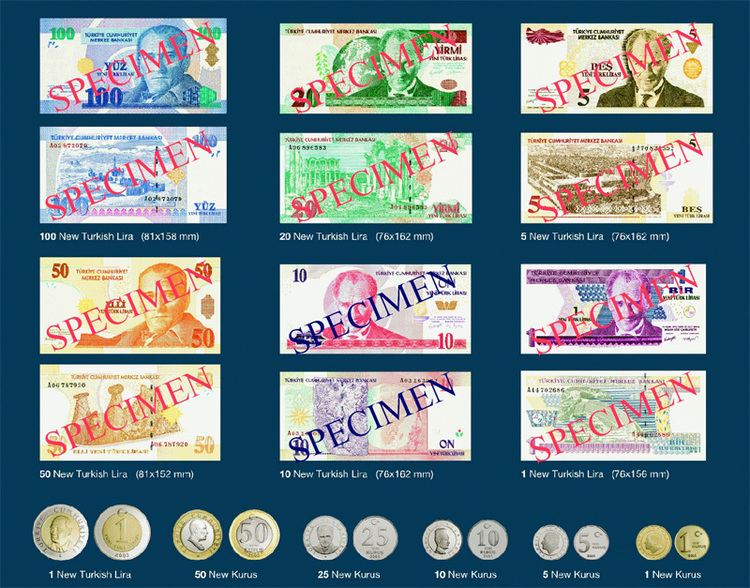Code TRY Symbol YTL | 1/100 new kuruş | |
 | ||
Banknotes 1, 5, 10, 20, 50, 100 new lira Coins 1, 5, 10, 25, 50 new kuruş, 1 new lira User(s) Turkey (to 1 January 2009)
Northern Cyprus (to 1 January 2009) | ||
The new Turkish lira (Turkish: Yeni Türk Lirası) was the currency of Turkey and the de facto independent state of the Turkish Republic of Northern Cyprus between 1 January 2005 and 1 January 2009 which was a transition period for the removal of six zeroes from the currency. The new lira was subdivided into 100 new kurush (yeni kuruş). The symbol was YTL and the ISO 4217 code was TRY.
Contents
History
Because of the chronic inflation experienced in Turkey from the 1970s through to the 1990s, the old lira experienced severe depreciation. Turkey has had high inflation rates compared to developed countries and suffered hyperinflation. From an average of 9 lira per U.S. dollar in the late 1960s, the currency came to trade at approximately 1.65 new lira per U.S. dollar in late 2001. This represented an average inflation of about 38% per year. Prime Minister Recep Tayyip Erdoğan had called this problem a "national shame". With the revaluation of the Turkish old lira, the Romanian leu (also revalued in July 2005) briefly became the world's least valued currency unit.
In late December 2003, the Grand National Assembly of Turkey passed a law that allowed for the removal of six zeroes from the currency, and the creation of the new lira. It was introduced on 1 January 2005, replacing the previous lira (which remained valid in circulation until the end of 2005) at a rate of 1 new lira = 1,000,000 old lira.
The official name of the currency is "New Turkish Lira". According to the Central Bank, the word "new" (yeni) is only a "temporary" measure. A news agency reported that "new" will be removed on January 1, 2009. The same source also indicated that the banknotes will have "different shapes and sizes to prevent forgery". The issuance of a new highest denomination, 200 lira, is contemplated at the same time.
Coins
Coins were introduced in 2005 in denominations of 1, 5, 10, 25 and 50 new (Yeni) kuruş and 1 new (Yeni) lira. The 1 new (Yeni) kuruş was minted in brass and the 5, 10 and 25 new kuruş in cupro-nickel, whilst the 50 new kuruş and 1 new lira are bimetallic. All coins show portraits of Mustafa Kemal Atatürk.
To the dismay of the European Central Bank, the sizes and compositions of the 50 new kuruş and 1 new lira coins clearly resemble those of the €1 and €2 coins respectively. (See comparison photo in [1] of YTL 1 coin and €2 coin.) This could cause confusion in the eurozone. It also caused trouble to businesses using vending machines (particularly at airports) in the eurozone since a number of vending machines at the time accepted the 1 new lira coin as a €2 coin. Since €2 is worth roughly four times more, vending machines affected had to be upgraded at the expense of their owners.
